Chef Rebecca Tip!! - January
January 12th, 2021
Try making a different soup, stir-fry or quiche each week from the bounty of broccoli/broccolini 🥦,
brussels sprouts, beets, carrots 🥕, cauliflower, chard, kale🥬, leeks, mushrooms, mustard greens,
onions, sweet potatoes🍠, squash or turnips that you’ll find in your garden or at your local Farmer’s
Market.
I used to struggle with soups, but when I stopped trying to follow a precise recipe and
instead opted to sauté, simmer, and stir in whatever was ready to harvest from my garden (and/or
was left over from my meekly trek to Farmer’s Market) – I turned into somewhat of a super-soup 🥣
chef! I love combining chicken, leeks, mushrooms, garlic, onion, carrots and some kale into a
savory pie 🥧 – add a nice glass of red wine 🍷, and voilá– a restaurant-worthy winter meal! Salud!

Sometimes, in the midst of a crisis, a beautiful idea blooms.
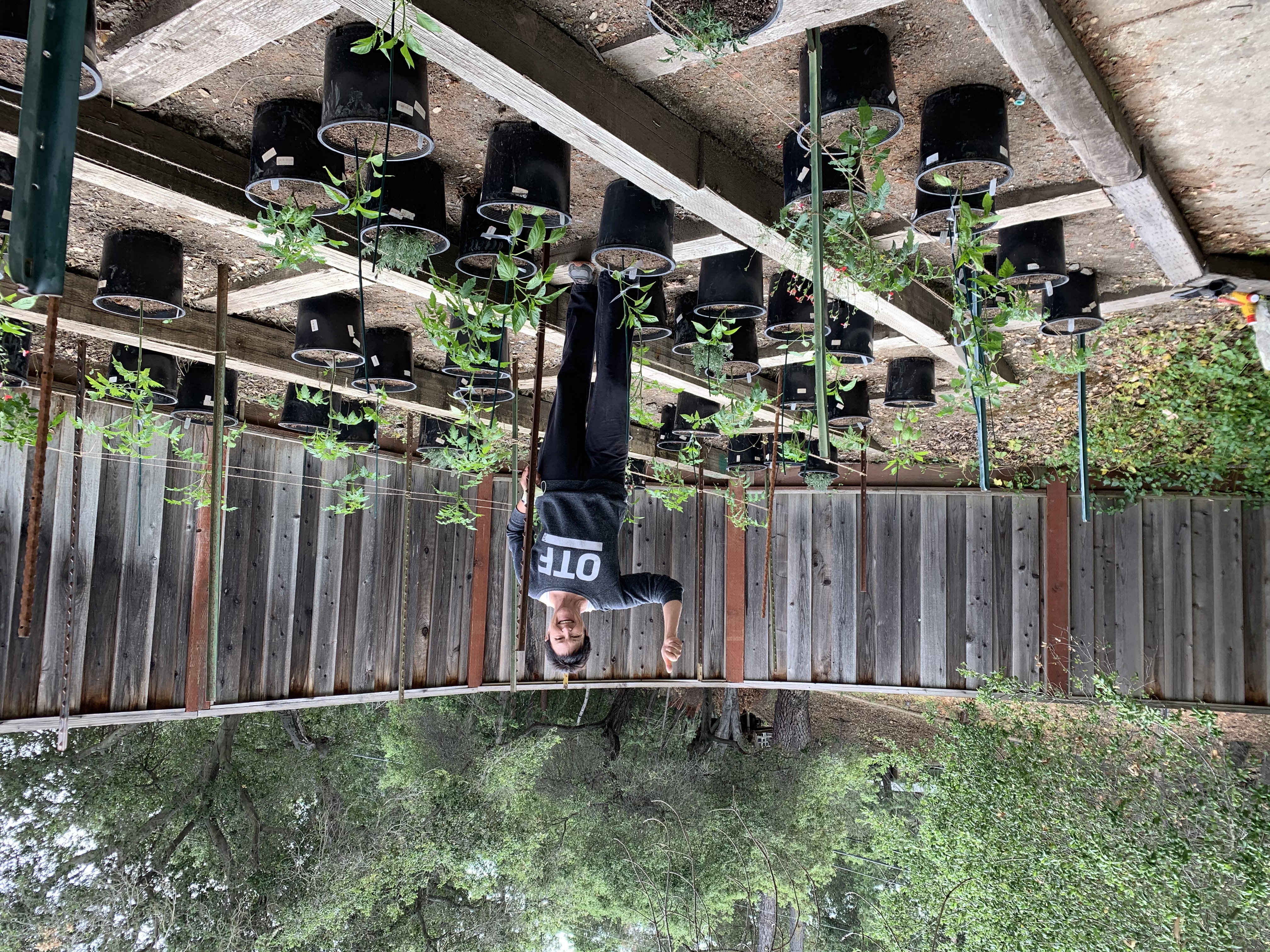
Rebecca in her Growing2Shine Garden!
When COVID-19 forced the cancellation of the Santa Clara County Master Garden- ers’ massive Spring Garden Market, master gardener Rebecca Jepsen worried about the thousands of tomato and pepper plants that were seeded up and ready to sell.
“I thought, I have to find
a way to help,” she says. “I couldn’t bear the thought of any of those plants finding their way into a compost pile!”
So Jepsen, a real estate agent with Golden Gate Sotheby’s International Realty in Los Gatos, hatched a plan to purchase more than 200 of the plants and donate them
to a garden that supports the safety-net organizations that help feed the homeless and those who are food-insecure.
The only problem? She couldn’t find a garden explicitly devoted to that cause. So, she decided to create one herself.
Jepsen phoned her friend AJ Anderson, the director of facili- ties and real estate for Uplift Family Services, a nonprofit that provides mental and behavioral health treatment, crisis intervention, and hous- ing services to at-risk individu- als and families. Uplift’s Los Gatos campus contains a small garden that Jepsen thought might have space for most of the plants.
To Jepsen’s delight, Ander- son agreed to help. “I thought it was fantastic; there’s nothing like being able to give back to families in need,” says Ander- son, who calls Jepsen “one of the kindest souls I’ve ever met.”
With a facility secured, Jepsen called on her network
of friends, clients, and master gardeners, asking for assistance. And on May 2, a dozen people gathered, in masks, to plant some 150 tomato and pepper plants, plus 14 pollinator plants (lavender and salvias), on the roughly 120-square-foot plot.
Jepsen intends to harvest them and then drive the produce, in her husband’s
pickup truck, to various food banks all season long. And she emphasizes that anyone who has the desire and the means can do the same.
“For less than $1,000, I can grow a substantial amount of food to help feed the home- less,” she says. “If I can do this, anybody can do this.”
That includes businesses. With employees of Bay Area technology companies work- ing from home indefinitely, most corporate parking lots
sit empty. Says Jepsen: “If [companies] wanted to dedi- cate five parking stalls, they could go get five-gallon pots, a couple of yards of planting mix, and they could grow tomatoes, peppers, and seasonal produce all year round — as long as you have an irrigation source or people who promise to show up and water.”
This isn’t the first time Jepsen has launched a community-service project, either. Last year, she assem- bled a team of volunteers to rebuild, repair, and beautify the Uplift Family Services campus. And in her home garden, she grows way more produce than she needs and gives the excess to her neigh- bors, friends, and clients.
So, what drives her altruism?
“My dad taught me that if you’ve done well, you need to do good. That’s my guiding light, my true north,” Jepsen says. “A huge part of my life is about giving back,” she adds, “and finding ways to build commu- nity and bring people together.”
That philosophy informs her business, too. “I see real estate as a way to give back to people and to serve people,” she explains.
Indeed, Jepsen devotes the same level of effort to
her clients that she does
to her service projects.
She has personally helped senior clients downsize their belongings and move, and stays connected with them well after the sale. And
while property showings are permitted during the COVID- 19 crisis, she refuses to let prospective buyers enter the homes of high-risk residents. (“If it takes longer to sell, that’s OK,” she says. “The health, safety, and best inter- ests of my clients is the most important part.”)
Thanks to her former career in high-tech sales and market- ing, Jepsen is also an expert negotiator with a long history of getting sellers the highest price in their neighborhood in the shortest amount of time. “It matters that I do the very best job I possibly can for each and every one of my buyers and sellers,” she insists. “It lights me up — just like creat- ing community does.”
As for the garden, Jepsen intends to use it to provide fresh, nutritious produce to food-insecure populations for as long as she can — and she encourages others to do the same. In fact, she’s planning
to launch a nonprofit, called Growing2Shine, which will create gardens where commu- nities can grow food, harvest, and even share meals together.
“I want to be a catalyst. I want to show others that they can make a difference; it’s really
not hard,” she says. “If anybody wants to do a similar project
at their company, church, or in their own backyard, just call me — I am here to help!”
Rebecca Jepsen: 408-357- 3990, rjepsen@ggsir.com, www.rebeccajepsen.com, www. growing2shine.com.
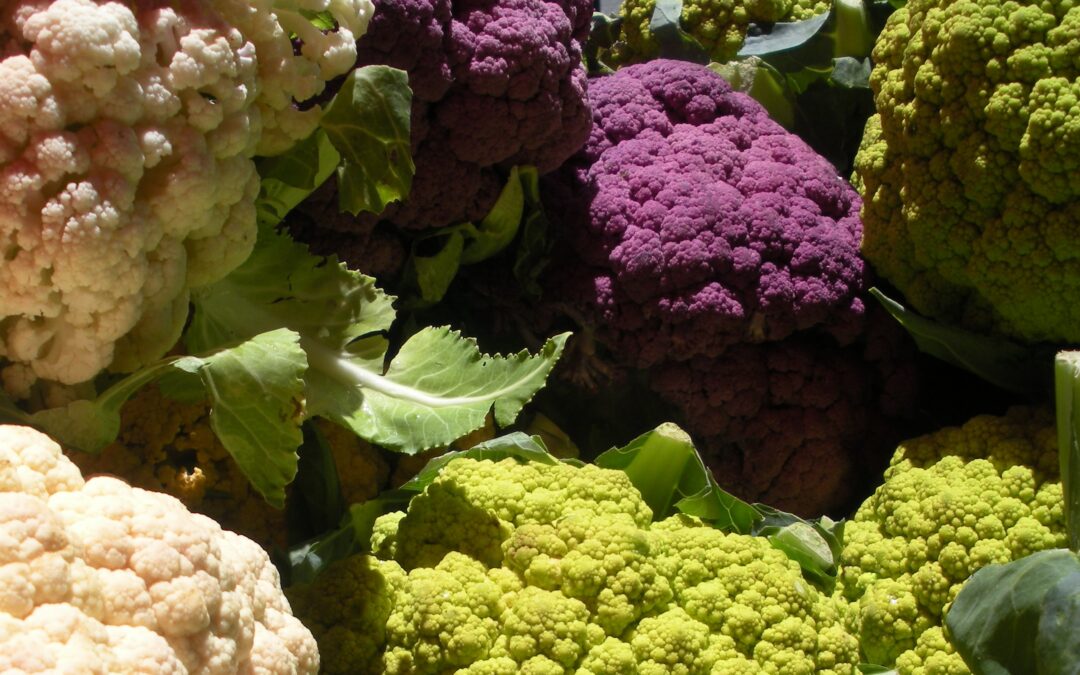
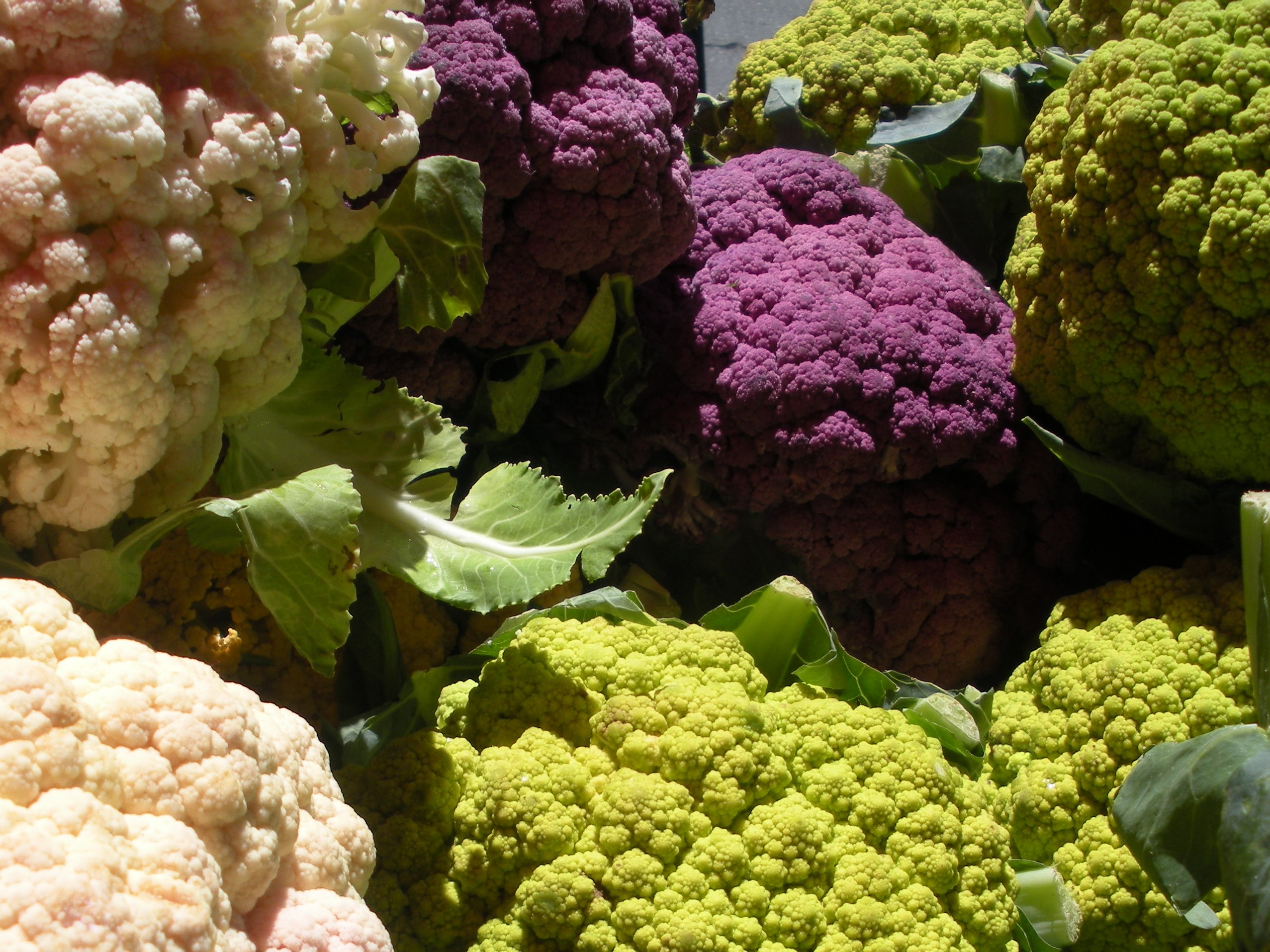
There is nothing better than a homemade pot of soup on a cool, fall evening — and growing your own cool-season herbs, veggies and leafy greens will have you cooking up savory meals all season long.
If you haven’t tried gardening in our so-called off-season, you are missing out on a vibrant and productive time of year here. There are literally hundreds of varieties of vegetables, fruit and flowers that come into full production during the Bay Area’s fall and winter months, including brassicas (broccoli, cabbage, cauliflower and Brussels sprouts), root vegetables and leafy greens, such as mizuna, kale, chard and spinach. Peas, beans, potatoes, onions and — my personal favorite – garlic thrive at this time of year, too.
Gardening in the cool season is more relaxed and less demanding than summer gardening. Most of these crops grow at a slower pace, and Mother Nature
generally does much of the watering for you. However, if you are planning to take the winter off from edible gardening, you might want to consider planting a cover crop that will help nurture and improve your soil for next summer’s garden.
Cover crops (buckwheat, rye, clover, fava beans) not only provide nitrogen to the soil, they also help loosen the soil and suppress weeds. And they help feed and support our local birds, bugs and bees with their flowers and seeds.
You’ll find all the plants and info to get your garden going at the
upcoming Master Gardener Fall Garden Market, held in conjunction with the Fall Festival at San Jose’s Martial Cottle Park from 10 a.m. to 3 p.m. Oct. 5. Admission is free; parking is $6.
The Fall Festival offers such family-friendly attractions as a pumpkin patch, carnival games and petting zoo, as well as DIY craft workshops, farm tours, live music, square dancing and food trucks.
Swing by the garden market’s help desk with your garden questions, where volunteers can help analyze plant or pest problems if you bring a sample. Educational talks this year will include waterwise landscaping, planting perennials and growing garlic.
The market offers a wide array of plants, including Asian greens — Chinese broccoli, pak choi, tatsoi and nozawana turnip greens — as well as beets, brassicas, herbs and leafy greens like cilantro, parsley, chicory and escarole. There will be flowers, too, including agrostemma, snapdragons and sweet peas. Flowers not only add beauty, they also help attract bees and beneficial insects necessary for pollination and fending off the “bad bugs” in the garden.
Growing your own food is not only enjoyable, it’s important. You’ll eat better, spend more time outdoors, waste less, and help support and feed our native birds, bees and bugs. Bonus: kids love to eat what they grow!
October 5, 2019 10 a.m. – 3 p.m.
Martial Cottle Park
5283 Snell Ave., San Jose, CA
By REBECCA JEPSEN, CORRESPONDENT
Phone: 408-691-5659 email: rjepsen@apr.com
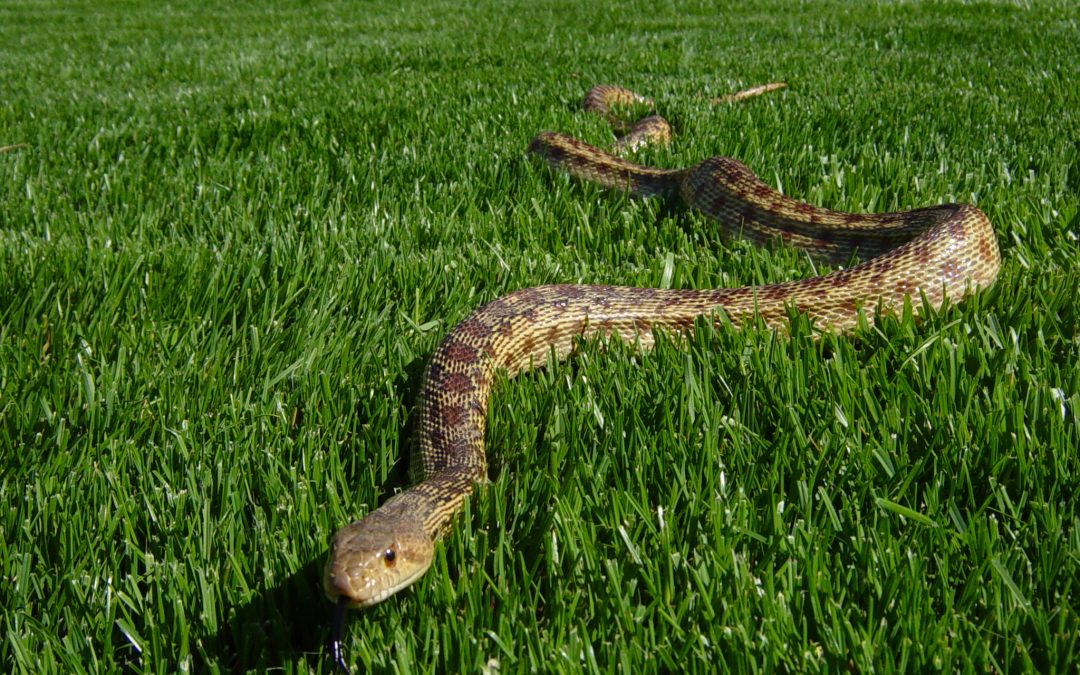
Some 45 of my Master Gardener friends and I recently went on a field trip to Berkeley’s UC Botanical Garden and Alice Water’s Edible Schoolyard. And, yes, we were just as excited and enthusiastic as a bunch of school kids.
Of course, we were wowed by all the incredible plants from around the world that we got to see, but we were especially excited about the snakes!
I know you may not want to adopt a pet snake, although many people do, but they are extremely beneficial to have slithering around your garden and landscape. Snakes prey on mice, rats, moles, voles, lizards, frogs, slugs and even other snakes.
More than 30 species of snakes make the Bay Area home. Of those, only rattlesnakes are venomous to humans.
The Pacific Gophersnake is the most common snake in Northern California and is often mistaken for a rattler. It is generally brown or tan with dark gray, black or brown spots along the length of its body. Adults are 4-5 feet long.
This snake is diurnal, meaning it hunts during the day and sleeps at night. It is found in woodlands, grasslands, chaparral, agricultural and riparian areas from sea level to the mountain ranges. If threatened, it will flatten out its body and shake its tail. Although it has no rattle, the movement against dry grass can mimic the sound of a rattlesnake.
The Northern Pacific Rattlesnake can range in color from olive to brown to black. It has dark brown and tan blotches along its body and medium to dark bars at the tail. Adults are typically 3-4 feet long.
Usual habitats includes seaside dunes, rocky hillsides, woodlands, grasslands and sometimes residential landscapes. You will often find them on a hiking trails or bike paths soaking up the sun.
A rattlesnake has a triangular head and relatively thin neck. The body is thick, dull and non-glossy. A gopher snake’s head is more pointy and just a bit bigger than its neck. It has a slender, glossy body and a pointed tail.
King snakes are extremely common throughout California. They are either black or dark brown with light striped bands circling their bodies. Adults are generally 3-4 feet long.
They can be found in nearly all habitats — forests, woodlands, grasslands, wetlands and even the desert. They have been known to eat rattlesnakes, as they are immune to its venom.
The Northern Rubber Boa are usually a fairly solid shade of brown, tan, pink or olive green. They have small, smooth scales and look, well, very much like rubber. They only grow to about 2 feet in length.
Although they are very common, they are generally nocturnal so you may not see them. They are often found in meadows, grasslands, chaparral and deciduous and coniferous forests.
Pacific Ring-necked snakes are beautiful small, thin, smooth-scaled snakes. They are black, gray or dark olive green with vivid orange rings around their necks. The underside is bright yellow or orange with black specs. They only grow to about 3 feet long and will coil their tails (showing off their bright colors) when threatened.
They like moist habitats such as wet meadows, gardens, farmland or forests. They eat insects, worms, lizards, salamanders and tadpoles.
Other common snakes you may find while out hiking, biking or even hanging out in your backyard are: Gartersnake, Nightsnake, Striped Racer, Sharp-tailed Snake, and many others.
Again, you may not learn to love your snakes, but please learn to appreciate and respect them. They really are quite good at taking care of the rodents that are wrecking your lawn and eating your tomatoes!
Rebecca Jepsen is a Santa Clara Master Gardener.

A TRULY beneficial snake!

Are grubs friends or foes? That really depends on where they are, how many you have and your tolerance for creepy-crawlies in your garden.
White grubs are the larvae of several species of scarab beetles. They are weird, kind of alien-looking little creatures that curl up into a C-shape when disturbed. They tend to grow to around 1-inch long, but some species can get much larger.
I have three raised beds in my garden area and replant them every spring and fall. For the last couple of years, I have found an unusually large population of what I believe is a kind of grub called Cyclocphala, or masked chafers. The larvae have brown heads and legs and have dark stripes across their backs. The adults (beetles) are golden-brown and have an almost armor-like, shiny coating on them.
“It is not possible to identify these grubs without looking closely at features such as mouthparts and small hairs (called setae) located on their bodies,” said Karey Windbiel-Rojas, with the University of California Statewide Integrated Pest Management Program. “However, they are the larvae of scarab beetles, and based on where you found them, they could be masked chafers, green fruit beetles, or something similar. What they are very likely NOT are Japanese beetle larvae, since those are more or less non-existent in California.”
Handpicking grubs from raised beds (as I do) and containers can be all the control needed. I have had no noticeable plant damage in my beds.
If you or a neighbor have chickens, they absolutely love grubs and will be overjoyed to help you cut down the population.
Grubs can, however, do major damage to turfgrass. Most damage occurs during late summer or early fall. You will see patches of brown, drying lawn in the infested areas. Additional damage is often done by moles, voles, birds or skunks that are digging in the grass to feed on the grubs.
Before taking any control measures, dig around the root level of the grass to confirm that in fact the damage is being caused by grubs. If you find more than six grubs per square foot, you may want to take action.
Since grubs feed close to the surface, aerating the soil can kill significant numbers of them.
Nematodes (tiny, microscopic roundworms) can also be applied to control grubs. They should be applied when the grubs are young and not overpopulated. It is best to do so in late summer or early fall. A second application is highly recommended. Be sure to do your research about the proper way to prepare and apply nematodes for grub control.
If these natural measures don’t work, it is important to know what kind of grub (or any other kind of pest) you have before deciding to use chemical control. Get advice about the right chemical to use and the right amount necessary to get the job done. A wrong decision can mean wiping out other species. You can take a grub (or other pest) specimen into your local Master Gardener office to get information about what to do.
Rebecca Jepsen is a Master Gardener with the Santa Clara County Master Gardener Program of the University of California Cooperative Extension. For more information or to reach Jepsen or other Master Gardeners, visit www.mastergardeners.org.
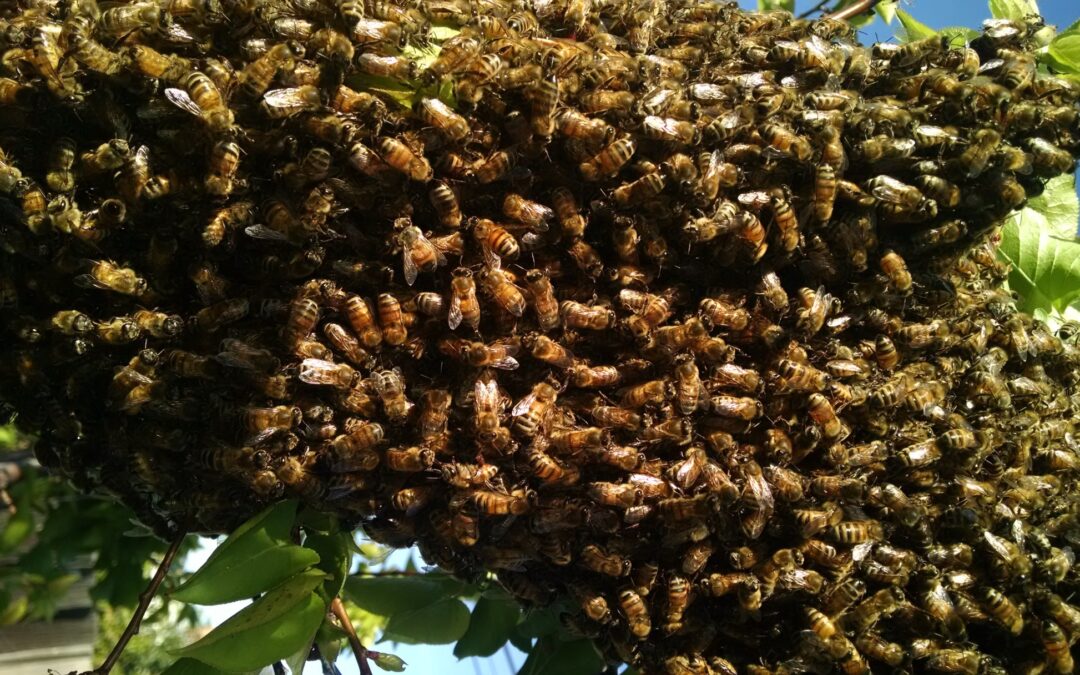
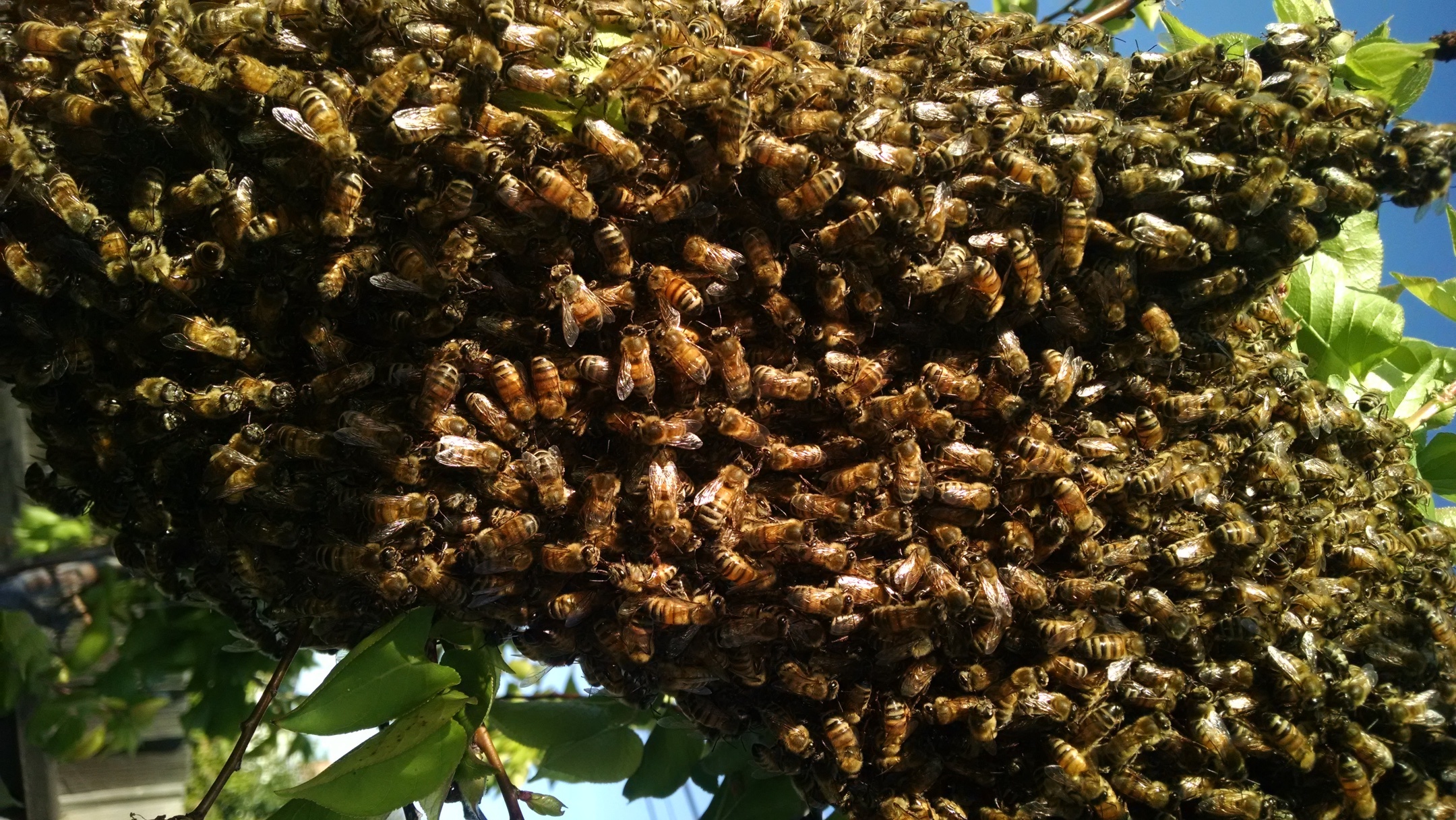 Although a huge, moving, whirl of bees may surprise and alarm you – have no fear. The beautiful, majestic dance taking place in front of you is being performed by our tremendously beneficial honey bees!
Although a huge, moving, whirl of bees may surprise and alarm you – have no fear. The beautiful, majestic dance taking place in front of you is being performed by our tremendously beneficial honey bees!
Most swarming activity takes place from April through May. Bees don’t swarm during the rain, so this year we will most likely see the timeframe pushed back a few weeks.
Honey bees, Apis mellifera, swarm for one of two reasons. Either the hive has become too crowded so they split into two groups (or more), with one group remaining in the existing hive. Or they abscond. In this case, all bees including the queen abandon the existing hive completely due to lack of food or water, parasite or disease infestation, frequent disturbance by humans and/or animals, weather changes, poor ventilation or problems with the queen.
Western honey bees aren’t nearly as likely to abscond as African honey bees, (a hybrid of South American and European bees known as Africanized honey bees), which tend to swarm more and be a bit more defensive as well.
Worker bees are able to detect when it’s time to swarm due to overcrowding of the hive or the lack of pheromone production from the queen. In preparation for the swarm, the workers will deprive the queen of food in order to slim her down so she can fly. They will also agitate and run her around in order to prevent her from laying many eggs. If they are going to swarm, they will create new queen cells and allow the queen to lay eggs so a new queen can emerge and take over the hive.
Besides making honey, honey bees are essential for pollinating approximately 90 percent of our crops globally. Many of our favorite foods like almonds, most of our cherries, apples, blueberries and other fruit and nut crops wouldn’t exist without these hard-working bees.
According to Deb Conway with GirlzWurk in Saratoga, “Honey bees aren’t usually a problem, as they normally set up their hives in tree cavities, shrubs, light poles, or abandoned buildings. However, they can become a nuisance when they take up residence in the walls of your home, garden shed or in your water meter.”
That’s when it’s time to call someone like Deb who can come and rescue the hive.
Last year was a particularly bad year for honey bees. Some bee keepers reported up to a 90 percent loss in their hives in 2018. Causes for this include varroa mite infestations, increased pathogens due to the warm weather, increased use of pesticides and a decrease in diversity of food sources.
So, what can we do about a swarm? “If you leave the bees alone, they will leave you alone.,” said Dr. Elina L. Niño, honey bee expert at UC Davis. “It only takes a few hours or at most a day or two for them to find and settle into their new home.”
Bees, as well as our other important and beneficial insects, are struggling. Our tendency to develop land and our extensive use of harmful chemicals is wiping out their natural habitat.
The public can truly make a difference by ceasing to use pesticides and by planting an array of beautiful, attractant plants such as ceanothus, lavender, echium, rosemary, penstemon and mint (only recommended in containers because it is so invasive). For more bee-friendly plant ideas, visit the UC Davis Häagen-Dazs Honey Bee Haven website.
Let’s all commit to creating safe and nurturing spaces in our backyards, gardens (and yes, even on those balconies and decks) where our much-needed pollinators and beneficial insects can not only survive, but … thrive!
For help in relocating a swarm or hive or to contact a local bee keeper, visit the Santa Clara Valley Beekeepers Guild’s website, which has information about Santa Clara as well as surrounding counties.
Rebecca Jepsen is a Master Gardener with the Santa Clara County Master Gardener Program of the University of California Cooperative Extension. For more information or to reach Jepsen or other Master Gardeners, visit http://www.mastergardeners.org.